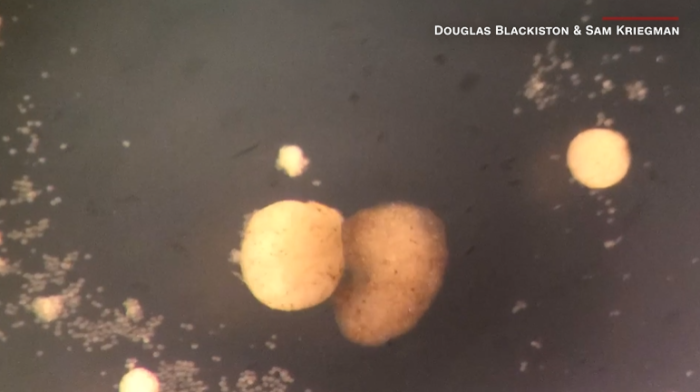By James Field | News | November 30, 2021 |
By James Field | News | November 30, 2021 |
Do you ever feel like you sneezed so hard you blew yourself into an alternate dimension? Not one of the cool ones where rivers flow with maple syrup and you can harvest bacon right off the living pig, but one where scientists watch every cautionary cinematic parable with an eye towards making it come true as soon as possible. Not content with full-size killbots or avian surveillance drones, some bright souls at the University of Vermont, Tufts, and Harvard last year built the world’s first living, self-healing robots out of African clawed frog stem cells. They’re called xenobots, which definitely doesn’t sound like the kind of thing Elon Musk would fund and then dump in a river to see what happens. These miniature abominations are generated by scraping cells off a frog embryo, incubating them, and carving the resulting blob into the appropriate shape for their intended task.
“We can imagine many useful applications of these living robots that other machines can’t do, like searching out nasty compounds or radioactive contamination, gathering microplastic in the oceans, traveling in arteries to scrape out plaque.” said team co-leader Michael Levin Other applications might include storing and delivering precise dosages of drugs or digesting the complex organic compounds in oil spills. At the time Joshua Bongard, a computer scientist with the University of Vermont said “These xenobots are fully biodegradable. When they’re done with their job after seven days, they’re just dead skin cells.” Which makes sense, if you think about it. If you’re going to release organic machines into the environment capable of self-repair, you want a built-in expiration date. After all, dissolving microplastics in the ocean is all well and good, but you probably don’t want them leaving the beach on your car’s undercarriage.
That was 21 months ago, and lost in the general cacophony of impending doom that was 2020. Now, scientists are “excited” to report that not only are their microscopic harbingers capable of self-repair, but they can make new robots. “I was astounded by it,” said Dr. Levin with what I can only assume was a nervous chuckle. “Frogs have a way of reproducing that they normally use but when you … liberate (the cells) from the rest of the embryo and you give them a chance to figure out how to be in a new environment, not only do they figure out a new way to move, but they also figure out apparently a new way to reproduce.”
Dr. Levin clearly never watched a single Jurassic Park movie, because after scientists discovered a few of these tiny terrors making copies of themselves they immediately used a supercomputer to test billions of body shapes and determine which were most effective at self-replication. They ended up with something like Pac-Man that gathers hundreds of stem cells in its “mouth” and, after a few days, releases new xenobots into the environment. Interestingly, the now-extinct Gastric-brooding frog did something similar, swallowing fertilized eggs and allowing them to grow to full froghood in its belly before they crawl out momma frog’s mouth. There’s an oral sex joke in there somewhere, but I’ll leave it to your imagination.
This piece is tongue-in-cheek, but there are genuine concerns hidden in the hyperbole. Apart from Johnny Appleseed spreading fruit trees across the United States, it’s difficult to think of a time when humans introduced a new species to the environment and it went well. After spreading rats, cats, rabbits, toads, starlings, and goldfish across the globe it’s difficult to think of a scenario where humans place regenerative, reproducing biological robots in the wild and don’t lose control. Knowing that the Defense Advanced Research Projects Agency (DARPA) funds the project isn’t comforting either, though it makes sense. It’s true that the Agency has been at least partially responsible for many of the innovations running the modern world, from vaccines to the internet. But the military applications for microscopic, programmable organic machines are almost limitless. Perhaps you drop a variant that digests oil into a nation’s petroleum reserves rather than Exxon’s latest spill. Maybe they’re used to deliver poisons or viruses to political opponents, or programmed to wreak havoc on the circulatory system. It’s less traceable than Polonium or Novichok poisoning. Still in its infancy, the field of organic robotics is costly and time-consuming. Supercomputers are required to design and carve the appropriate shapes from the stem cells. But once upon a time 3D printing was also prohibitively expensive for most organizations. Now you can buy a home printer for a couple of grand, or get your desired product printed at Staples.
But I’m sure it’s fine, and my paranoid fantasies of rubbery, tentacular amphibians roaming the earth in an endless search for organic material will never come true. After all, every year since 2016 has only been better than the previous one, right? Right?!
Source: CNN
← Barbados Got Rid of the Monarchy Then Made Rihanna a National Hero | Peter Jackson Gives A Detailed Series Of Interviews On The Making Of ‘Get Back’ On Colbert →
Header Image Source: CNN screenshot
Privacy Policy / Advertise
Buy a Pajiba T-Shirt at the Pajiba Store
Scientists Create Self-Replicating Organic Robots in Defiance of All Common Sense – Pajiba




